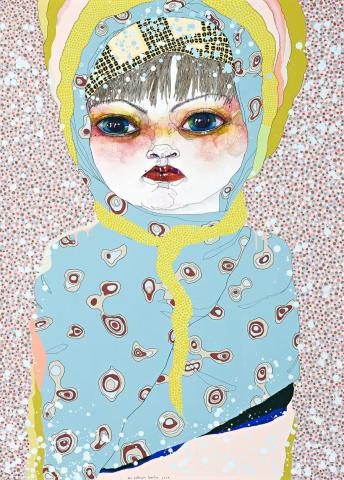GIRL #19, 2004
DEL KATHRYN BARTON
synthetic polymer paint, watercolour, gouache and ink on polyester canvas
120.0 x 86.0 cm
signed, dated and titled verso: del kathryn barton / 2004 / “girl #19”, inscribed verso with medium
Ray Hughes Gallery, Sydney
Private collection, Sydney
Girl, Ray Hughes Gallery, Sydney, 2004
Del Kathryn Barton is represented by Karen Woodbury Gallery, Melbourne
Awarded the prestigious Archibald Prize in 2008 for You are what is most beautiful about me, a tender self-portrait with her two children Kell and Arella, Del Kathryn Barton is undoubtedly one of the most critically acclaimed, eagerly sought-after figures in Australian contemporary art. Bearing affinities with elements of Pop Art and Surrealism, including the eroticised poupée of Hans Bellmer, her richly illustrative work offers a complex, often disorienting meditation upon the dichotomous nature of beauty which, by highlighting both its sensual and abject; dimensions, seeks to undermine simplistic notions of the feminine. Not surprisingly perhaps, Barton also references the contradictions inherent in society's celebration of female beauty through the shallow space of fashion 'its collapse of life into a pose and collapse of character into a decorative appearance. For all their contemporary fashion allusions however, Barton's lithe figures also seem strangely of another time - their big, overstated eyes recalling the feminine vapid, doe-eyed cuteness in Japanese manga or the unearthly gaze often found in naive art.'1
In her obsessively detailed suite of portraits exemplified here by Girl #19, Barton not only indulges her fascination with the world of children, but continues her enduring preoccupation with the female face as a repository of thoughts, emotions and fantasies. Occupying an imaginary realm adorned and embellished with tiny flourishes of foliage, abstract shapes and colourful patterns, the portraits betray a compulsive beauty in their infinitely rendered detail. Yet if alluding to the imaginary, naive world of children, at the same time the direct, steady gaze of the sitter implies a certain knowingness or wisdom - indeed, what do these childlike girls reveal with their overblown faces and simultaneously conceal with their innocent stare? Appealing to the basic human impulse to imagine the character behind a face, thus such images both delight and beguile in their disconcerting fluidity between real and imaginary, representation and subjectivity; as Barton herself muses enigmatically, 'I have a face, but a face is not what I am. Behind me lies a mind, which you do not see but which looks out on you. This face, which you see but I do not, is a medium I own to express something of what I am. Or so it seems till I turn to the mirror.'
1. Colless, E., 'Del Kathryn Barton', Australian Art Collector, vol. 38, October - December 2006, p. 130
VERONICA ANGELATOS
